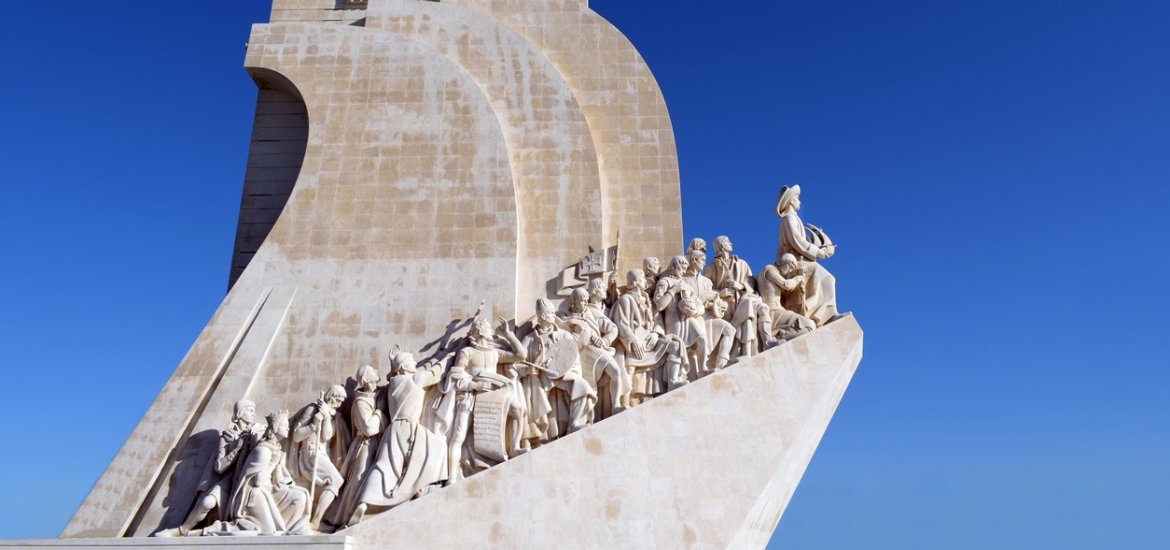
March 12, 2015
The Monument to the Discoveries, in Lisbon, deserves a visit. This monument was built in order to honor the Portuguese’s Discoveries. In fact, the courage and bravery of the Portuguese navigators crossed the world and discovered new lands. This remarkable time was unforgettable to the world. For that reason, this monument is a tribute to those times.
Discover the History, the details and the curiosities of this emblematic Portuguese monument.
The Monument to the Discoveries (Padrão dos Descobrimentos in Portuguese), located in Belém – Lisbon – was built in 1939 to honor the Portuguese Discoveries of the golden XV and XVI centuries. It is also known as Monument to Navigators and it was designed by the Portuguese architect José Angelo Cottinelli Telmo.
This monument is a must-see place in Lisbon. You can witness the beauty and the grandiosity of this building, and also learn the History associated with it. On the right bank of the Tagus River rests the image of the prow of a caravel (the ship used by the Portuguese navigators), with the shield of Portugal on both sides and the sword of the Real Casa de Avis (Royal House of Avis). This sculpture measures about 50 meters.
On each side of this monument, there are 33 heroes of the Portuguese Discoveries and the figure of Infante D. Henriques (Henry the Navigator) is on the edge of the caravel. He was the most important person of the Discoveries, and it seems he is still leading these Portuguese legends through the sea. This monument also includes heroes like Portuguese poet Luís Vaz de Camões, author of “The Lusiadas”, Pedro Álvares Cabral, who discovered Brazil, Gil Eanes, who was the first hero sailing beyond Cape Bojador, Bartolomeu Dias, the first person who crossed the Cape of Good Hope, and many other navigators, painters, mathematicians, cartographers, kings...
Near the monument, there is a Compass Rose with a diameter of 50 meters, drawn on the ground. Inside it, there is a map of the entire world, showing the routes of the Portuguese navigators. This treasure were a gift from Republic of South Africa (1960) to honor the Portuguese bravery. Indeed, Portuguese were the first fearless men that crossed the Cape of Good Hope. With this act, they proved that there weren’t any monsters here. A deserved gift, so.
The Monument to the Discoveries has another particularity. Here you can climb up to the sixth floor, by elevator or stairs. Try to achieve the highest point of this monument and enjoy one of the best views over Belém and Tagus River. In addition, this monument contains a storage where you can appreciate temporary exhibitions.
Furthermore, the Monument to the Discoveries contains some interesting curiosities. In 1940, Portugal opens the Portuguese World Fair. One of the main goals of the dictator António de Oliveira Salazar was the extraordinary exaltation of the Portuguese Discoveries. At that time, the most important purpose of this exhibition was to demonstrate the magnificence of Portugal to the world.
Furthermore, Belém suffered a radical reshuffle a lot of buildings and monuments were built. However, the demanding speed and the brittle materials used failed. The Monument to the Discoveries was the last monument built. And people say that Salazar didn’t like this monument. The reason? Allegedly, for him it overshadowed the beautiful Belém Tower.
One year later, a strong cyclone stole the main hero of this monument: the wind ripped the figure of Infante D. Henrique. In 1960, for celebrating the 500th anniversary of the death of Infante D. Henrique, the Monument to the Discoveries was rebuilt. The navigator returned to the prow and the monument remains towering up to today.
In fact, the Monument to the Discoveries is one of the proudest monuments for Portuguese people and, undoubtedly, a monument that illustrates one of the most important achievements of the World.
The Monument to the Discoveries is an important part of our tour around Lisbon. You can join our day tour or our trip at night and travel with us around Lisbon. Certainly, we will discover the impressive Portuguese History.